In this interview about green caskets, I am talking to Jonas Zahn, the founder of Northwoods Casket Company in Beaver Dam, Wisconsin. Jonas built his first casket two days before Christmas in 2002 — for his grandfather, who was a big John Wayne and Clint Eastwood fan. When his family couldn’t agree whether to bury or cremate his body, Jonas, then 29, offered to build “the toe-pincher,” modeled after the coffin he had seen in the 1992 western “The Unforgiven.”
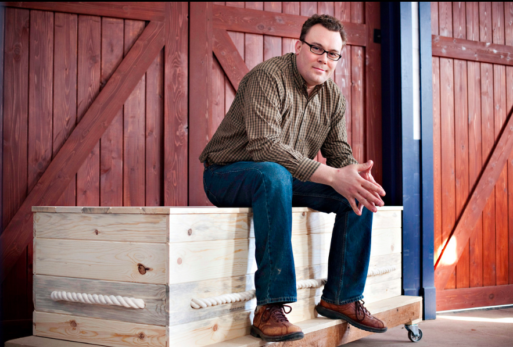
Jonas Zahn
It was a perfect fit for his grandfather and for Jonas, who would become the founder of the Northwoods Casket Company in 2010. From the start, part of his business plan has been to plant 100 trees for every casket sold, in cooperation with the Wisconsin Department of Natural Resources.
Editor’s Note: This interview has been edited for length and readability.
Laura B. Hayden: Hi Jonas and thank you for agreeing to talk to SevenPonds today. I don’t like to think a whole lot about the container in which I will be laid to rest, but the notion of a green casket is intriguing. First of all, just what determines if a casket is green?
Jonas Zahn: A green casket is usually part of a green burial which a lot of professionals in the industry have moved to calling a natural burial. I use both terms interchangeably.
What most people think of first with a green casket is biodegradability. Most green cemeteries require a solid wood casket, though more and more have backed off and realized that a few ounces of nails, a latch mechanism and a few hinges are not a big deal. I bring that up because with that modest amount of metal — which will oxidize probably faster than some bones do — the coffin can be priced under a thousand dollars. Green coffins that are designed with wood dowels or some kind of traditional woodworking joinery instead of any metal or less metal can cost $3000 to $5000.
Laura: Is biodegradable wood the only criteria?
Jonas: We use a number of other standards to measure how green our caskets are. Besides biodegradability we take into consideration toxicity, which has to do with what we are using for the finish, the upholstery and the adhesive. There are several different water-based finishes and natural oil finishes we can use to avoid any toxicity or any chemicals at all. The Green Burial Council looks at that pretty closely when they certify caskets for their level of greenness.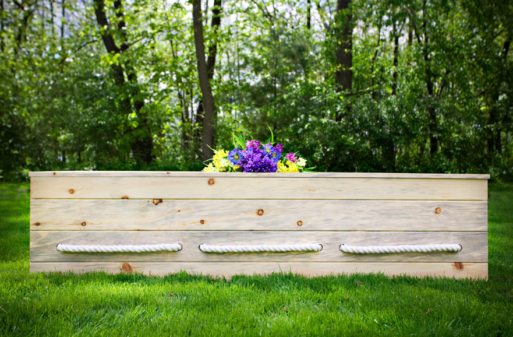
Laura: What are other standards for a green casket?
Jonas: Local sourcing is one because transportation has a negative impact on the environment. Local sourcing is also good for the local economy. All of our caskets (and cremation urns) are handcrafted in Wisconsin by the hands of local craftsmen and women. We use only local lumber sources that follow sustainable forestry practices.
Another important measure is carbon footprint. Now here’s the interesting thing about carbon footprint and caskets. Besides wood, there are seagrass and wicker caskets that are considered green. These are made in Indonesia. They may biodegrade faster than wood, but, weighing about 70 pounds, most are shipped to the U.S. by ocean cargo — which leaves a slight carbon footprint. However, they still have to be air freighted to their final destination — and the carbon footprint of a 70 pound seagrass casket that’s flown from, let’s say, Los Angeles to Denver or Chicago is more than double the one ton of CO2 emissions left by a steel casket manufactured in China and distributed via ocean cargo and truck. On the other end of the spectrum, the footprint left by a locally sourced simple pine box is maybe 50 pounds of CO2.
Laura: Those differences are startling. Are green caskets and burials changing American funeral traditions?
Jonas: Actually, humans have cared for their dead with natural burial practices for several millennium. It’s just recently that the western world has created an entire industry connected with funerals. Much of the rest of the world doesn’t utilize big steel caskets embedded inside a big concrete vault with a cadaver pumped with embalming fluid. This idea of preservation is really a post Civil War idea that let folk preserve and transport the deceased in order to give the family time to travel and have a funeral.
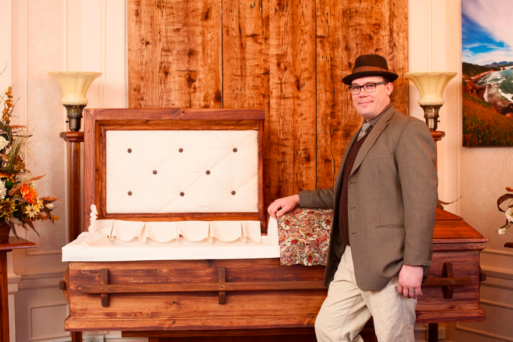
Still, today less than 2 percent of all interments in the United States are in certified green cemeteries. Many more — maybe most of our customers — want something sustainable, locally sourced and biodegradable, but they still want to be laid to rest in the same cemetery the rest of the family is buried in. They may even want the body to be embalmed for viewing. Those families will choose our green caskets for any number of reasons: for instance, because we plant trees for each casket we sell, because they are locally sourced, or because they are biodegradable, even though they may be interred in a traditional cemetery with a vault. We call that the many shades of green for a natural burial.
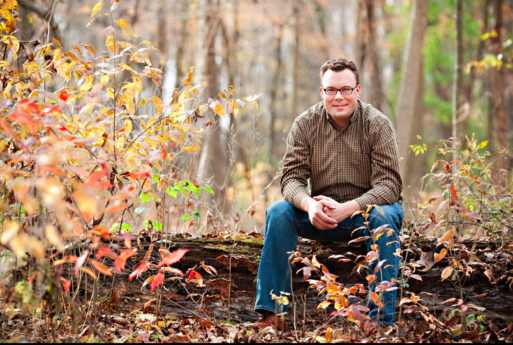
Jonas Zahn
Laura B. Hayden: Once consumers understand, as you told us last week, that a green casket is essentially a biodegradable container that leaves a very low carbon footprint, what else do they need to know?
Jonas Zahn: One of the first questions people ask is — is it legal to be buried in a green casket in their state? A green burial is legal everywhere. But what the law stipulates through most of the United States goes something like this: If the deceased’s body is not preserved, it must be interred or cremated within 24 hours.
Refrigeration is one means of preservation. I know a story about an unidentified indigent from Madison, Wisconsin, that was refrigerated for over seven years until it was decided how to dispose of him.
So, most people in charge of a green burial will either have the body interred within 24 hours of the death or preserved by refrigeration using a commercial cooler — or by using dry ice, which can work from several days to a week. You just keep adding more dry ice. Most bodies today — if they aren’t embalmed within 24 hours — are refrigerated until they can be embalmed. Then, once the embalming happens the body can hold for a week or two.
Laura: Will a funeral director usually offer the option of a green casket?
Jonas: Probably not.
Laura: So you have to be an informed consumer?
Jonas: Yes. At least say, “You know, I’ve heard about natural burials from NPR. Educate me. Is this something I want?” Most funeral directors are professionals who will do anything you ask — within the confines of the law — and there aren’t many restraints in the law. They’re not going to do a sky burial, or set the body out on the water in a burning boat or have a bonfire. We get those questions all the time. But a lot of people think a funeral has to be in a funeral home — it doesn’t. It can be in a home, which was a common practice before the 1960s. Mine is pre-arranged to be in my workshop. Funeral directors are responding to consumers’ wishes to do things other than what most people think of as a typical funeral.
Laura: Since you don’t sell directly to the public and a consumer has to ask about green caskets, how do you partner with funeral homes?
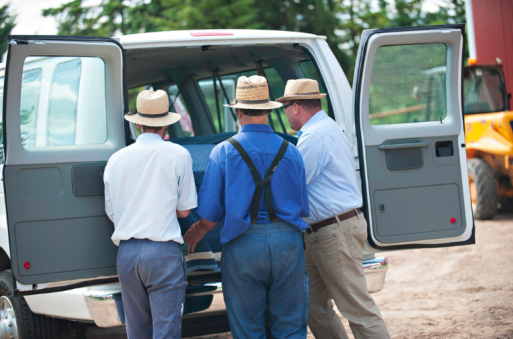 Jonas: Any funeral home in the United States can order from us. At times, there are some limitations. For instance, we can’t ship a casket to Maine in three days. It would be cost prohibitive. To get to the furthest reach in the continental U.S. during the winter would take about 10 days. Otherwise we could generally get one delivered in six or seven days. That said, 95 percent of our business is in Wisconsin. We do those deliveries with our own trucks and guarantee same or next day delivery. The other 5 percent is shipped nationwide as far as Maine, San Diego and Seattle.
Jonas: Any funeral home in the United States can order from us. At times, there are some limitations. For instance, we can’t ship a casket to Maine in three days. It would be cost prohibitive. To get to the furthest reach in the continental U.S. during the winter would take about 10 days. Otherwise we could generally get one delivered in six or seven days. That said, 95 percent of our business is in Wisconsin. We do those deliveries with our own trucks and guarantee same or next day delivery. The other 5 percent is shipped nationwide as far as Maine, San Diego and Seattle.
Laura: So, here in Connecticut where I live, I would I have to bring your name up to the funeral director?
Jonas: That’s the best way. There is a Connecticut Casket Company that makes a plain pine box that is similar to ours, which I would refer your business to when it is local and urgent. There’s a dozen or so others out there. They don’t always have websites, but there are ways. If you want to find a green casket, the funeral director will find one.
Laura: Usually purchasing a casket is fraught with emotion. How open are consumers to choosing a green casket for their loved one during such a difficult time?
Jonas: So, some people find themselves burying Mom or Dad or their spouse and they learn about green burial and they say, “You know we mentioned it in the past but really didn’t talk about it.” They’re reluctant if it wasn’t their loved one’s decision.
It’s different if Mom or Dad prearranged – not just talked about it at the dinner table but went to a funeral home, wrote their wishes down and put it in a file. You don’t have to prepay, and that document is portable. If they move or live somewhere else, their original funeral home will share the plan. Funeral homes work with one another.
If a natural burial is important to you, prearrangement is essential. I’d say 99 times out of 100 – whatever that prearrangement is — the family will follow it.
Laura: You’ve been quoted saying, “We’re a tree-planting business that happens to build caskets.” Tell me about your partnership with the Wisconsin Department of Natural Resources. Did you go to them with your idea to plant 100 trees for every casket you sell?
Jonas: I did. It’s a lot less glamorous than it sounds. I basically drafted a memorandum of understanding which was just a letter declaring my desire to do so with no legislative commitment. It’s basically a mission statement meant to help fund projects that the DNR would not have otherwise completed. Essentially, what I really wanted was to plant the right trees in the right places.
Laura: Where are the right places?
Jonas: Most of our trees are planted on taxpayer owned land: state parks, state natural areas and states forests. To sc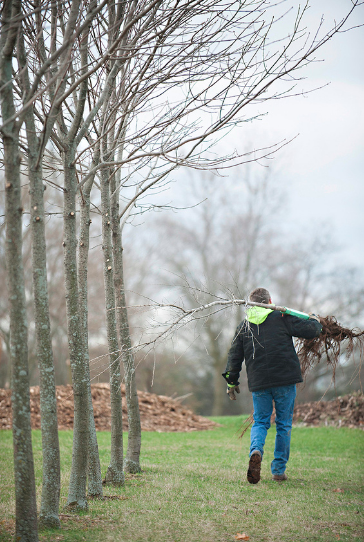 ale things, the DNR plants between 600,000 and a million trees a year. So my commitment to plant 10 million trees is a little more than a decade’s effort by the state.
ale things, the DNR plants between 600,000 and a million trees a year. So my commitment to plant 10 million trees is a little more than a decade’s effort by the state.
People have this idea we are planting rows and rows of pine trees. The state doesn’t do that anymore. When we do fund a project we’ll plant 10,000 to 15,000 trees — about 15 different species — and then another five species of fast-growing shrubbery for cover so that it becomes a wildlife habitat. That’s the purpose. Carbon sequestration and wildlife habitat.
Laura: Thanks so much, Jonas, for taking the time to speak with me today. I’ve learned a great deal.
Jonas: You’re very welcome.

 What Do We Need to Know About Green Caskets?
What Do We Need to Know About Green Caskets?


 Debating Medical Aid in Dying
Debating Medical Aid in Dying
 “Help Me, Helen”
“Help Me, Helen”















